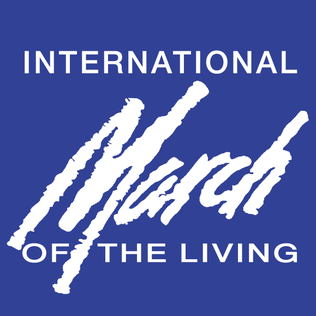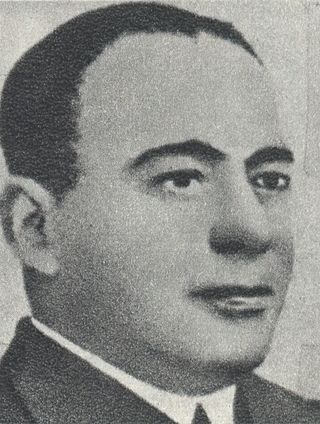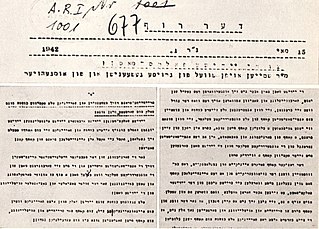Related Research Articles

The Warsaw Ghetto was the largest of the Nazi ghettos during World War II and the Holocaust. It was established in November 1940 by the German authorities within the new General Government territory of occupied Poland. At its height, as many as 460,000 Jews were imprisoned there, in an area of 3.4 km2 (1.3 sq mi), with an average of 9.2 persons per room, barely subsisting on meager food rations. Jews were deported from the Warsaw Ghetto to Nazi concentration camps and mass-killing centers. In the summer of 1942, at least 254,000 ghetto residents were sent to the Treblinka extermination camp during Großaktion Warschau under the guise of "resettlement in the East" over the course of the summer. The ghetto was demolished by the Germans in May 1943 after the Warsaw Ghetto Uprising had temporarily halted the deportations. The total death toll among the prisoners of the ghetto is estimated to be at least 300,000 killed by bullet or gas, combined with 92,000 victims of starvation and related diseases, the Warsaw Ghetto Uprising, and the casualties of the final destruction of the ghetto.

Emanuel Ringelblum was a Polish historian, politician and social worker, known for his Notes from the Warsaw Ghetto, Notes on the Refugees in Zbąszyn chronicling the deportation of Jews from the town of Zbąszyń, and the so-called Ringelblum Archive of the Warsaw Ghetto.

Yom HaZikaron laShoah ve-laG'vurah, known colloquially in Israel and abroad as Yom HaShoah and in English as Holocaust Remembrance Day, or Holocaust Day, is observed as Israel's day of commemoration for the approximately six million Jews murdered in the Holocaust by Nazi Germany and its collaborators, and for the Jewish resistance in that period. In Israel, it is a national memorial day. The first official commemorations took place in 1951, and the observance of the day was anchored in a law passed by the Knesset in 1959. It is held on the 27th of Nisan, unless the 27th would be adjacent to the Jewish Sabbath, in which case the date is shifted by a day.

The Ringelblum Archive is a collection of documents from the World War II Warsaw Ghetto, collected and preserved by a group known by the codename Oyneg Shabbos, led by Jewish historian Emanuel Ringelblum. The group, which included historians, writers, rabbis, and social workers, was dedicated to chronicling life in the Ghetto during the German occupation. They worked as a team, collecting documents and soliciting testimonies and reports from dozens of volunteers of all ages. The materials submitted included essays, diaries, drawings, wall posters, and other materials describing life in the Ghetto. The archive assembly began in September 1939 and ended in January 1943; the material was buried in the ghetto in three caches.
Zelig Hirsch Kalmanovich (1885–1944) was a Litvak Jewish philologist, translator, historian, and community archivist of the early 20th century. He was a renowned scholar of Yiddish. In 1929 he settled in Vilnius where he became an early director of YIVO.

The March of the Living is an annual educational program which brings students from around the world to Poland, where they explore the remnants of the Holocaust. On Holocaust Memorial Day observed in the Jewish calendar, thousands of participants march silently from Auschwitz to Birkenau.

Watkinson School is a private co-educational independent day school in Hartford, Connecticut, United States. Watkinson is situated on Bloomfield Avenue adjacent to the University of Hartford. It serves students from 6th through 12th grade. Watkinson also offers a postgraduate option, called The Academy at Watkinson, which allows students who have just graduated from high school to spend an additional year taking courses at Watkinson as well as the University of Hartford. Watkinson is the oldest independent school located within the city limits of Hartford.

POLIN Museum of the History of Polish Jews is a museum on the site of the former Warsaw Ghetto. The Hebrew word Polin in the museum's English name means either "Poland" or "rest here" and relates to a legend about the arrival of the first Jews to Poland. Construction of the museum in designated land in Muranów, Warsaw's prewar Jewish quarter, began in 2009, following an international architectural competition won by Finnish architects Rainer Mahlamäki and Ilmari Lahdelma.

Maurycy Orzech was a Polish economist, journalist, politician and a leader of the Jewish Bund in interwar Poland. He was one of the commanders of the Bund during the Warsaw Ghetto Uprising.

Noach (Nojach) Pryłucki or Noach Prilutski was a Jewish Polish politician from the Folkspartei. He was also a Yiddish linguist, philologist, lawyer and scholar of considerable renown. Pryłucki was a respected attorney and was said to have had "leadership over the scattered (non-Zionist) national clubs, societies, and groups".

The Anti-Fascist Bloc was an anti-fascist organization of Polish Jews formed in March 1942 in the Warsaw Ghetto. It was created after an alliance between leftist-Zionist, communist and socialist Jewish parties was agreed upon. The initiators of the bloc were Mordechai Anielewicz, Józef Lewartowski from the Polish Workers' Party, Josef Kaplan from Hashomer Hatzair, Szachno Sagan from Poale Zion-Left, Jozef Sak as a representative of socialist-zionists and Izaak Cukierman with his wife Cywia Lubetkin from Dror. The Jewish Bund did not join the bloc though they were represented at its first conference by Abraham Blum and Maurycy Orzech. According to Hersz Berlinski and Izaak Cukierman, the Bund did not join because they were waiting for a general socialist organization to be formed which would encompass non-Jewish Poles.
Henryka Łazowertówna ; alsoHenryka Lazowert, or incorrectly Lazawert, was a Polish lyric poet. While in general deeply personal in nature and of great emotive intensity, her poetry is not devoid of social concerns and patriotic overtones. She is considered one of the eminent Polish authors of Jewish descent.

"The Little Smuggler" is a famous poem by the Polish poet Henryka Łazowertówna (1909–1942). Written in the Warsaw Ghetto during the Holocaust, it tells the story of a small child who supports his starving family by — illegally, under Nazi dispensation — bringing over food supplies from the "Aryan side", thereby allowing for his family's survival while at the same time risking his own life. Indeed, the last stanza of the poem gives expression to the heroic child's fear — not of his own death but that of his mother who, in the event of the loss of her child, would be left without her daily sustenance.

Rokhl Auerbakh was an Israeli writer, essayist, historian, Holocaust scholar, and Holocaust survivor. She wrote prolifically in both Polish and Yiddish, focusing on prewar Jewish cultural life and postwar Holocaust documentation and witness testimonies. She was one of the three surviving members of the covert Oyneg Shabes group led by Emanuel Ringelblum that chronicled daily life in the Warsaw Ghetto, and she initiated the excavation of the group's buried manuscripts after the war. In Israel, she directed the Department for the Collection of Witness Testimony at Yad Vashem from 1954 to 1968.

Secret City: The Hidden Jews of Warsaw 1940–1945 is a 2002 book by Gunnar S. Paulsson. It was translated to Polish in 2008. Secret City is a social history of the Jews who escaped from the Warsaw Ghetto and tried to survive, living illegally "on the Aryan side". The book has received mostly favourable reviews, with several historians calling it "significant", "a milestone" and “riveting study".
"Like sheep to the slaughter" is a phrase that refers to the idea that Jews went passively to their deaths during the Holocaust. It derives from a similar phrase in the Hebrew Bible that favorably depicts martyrdom in both the Jewish and Christian religious traditions. Opposition to the phrase became associated with Jewish nationalism due to its use in Josippon and by Jewish self-defense groups after the 1903 Kishinev pogrom. During the Holocaust, Abba Kovner and other Jewish resistance leaders used the phrase to exhort Jews to fight back. In postwar Israel, some demonized Holocaust survivors as having gone "like sheep to the slaughter" while armed resistance was glorified. The phrase was taken to mean that Jews had not tried to save their own lives, and consequently were partly responsible for their own suffering and death. This myth, which has become less prominent over time, is frequently criticized by historians, theologians, and survivors as a form of victim blaming.

Gates of Tears: the Holocaust in the Lublin District is the first comprehensive study of the Holocaust in the Lublin District of Poland. It was written by David Silberklang and published in 2013 by Yad Vashem.
Cecylia Słapakowa was a Polish-Jewish journalist and translator. She is most known for her work for the Ringelblum Archive, then code-named the "Oyneg Shabbos" project, established by Emanuel Ringelblum.

Gustawa Jarecka was a Polish novelist. She was a daughter of Moszek Jarecki and Natalia Jarecka.
This is a select bibliography of English language books and journal articles about the history of Poland during World War II. A brief selection of English translations of primary sources is included. Book entries have references to journal articles and reviews about them when helpful. Additional bibliographies can be found in many of the book-length works listed below; see Further Reading for several book and chapter-length bibliographies. The External Links section contains entries for publicly available select bibliographies from universities. This bibliography specifically excludes non-history related works and self-published books.
References
- ↑ "Sam Kassow".
- ↑ No Happy Ending; Centerpiece of Jewish Film Fest Is an Unsentimental Look at the Holocaust in Hungary, Hartford Courant, SUSAN DUNNE, March 16, 2006
- ↑ Remembering the Holocaust Delegates Journey Overseas For Memorial Ceremony, Hartford Courant, KATHLEEN GORMAN, May 12, 1995
- ↑ Survivors' son will discuss "cultural resistance" at Yom HaShoah event, Zak Mazur, Wisconsin Jewish Chronicle, March 29th, 2002 "Survivors' son will discuss "cultural resistance" at Yom HaShoah event - the Wisconsin Jewish Chronicle". Archived from the original on 2011-07-16. Retrieved 2009-03-20.
- ↑ "Alumni". watkinson.org. The Watkinson School. Retrieved 5 July 2023.
- ↑ CT News (June 8, 2010), Samuel Kassow elected to American Academy for Jewish Research Jewish Ledger, Connecticut Edition. Retrieved December 22, 2013.
- ↑ Kassow, Samuel. "Interview With Samuel Kassow." Archived 2016-09-18 at the Wayback Machine Interview with Marshall Poe. Audio blog post. New Books in History. 30 Jan. 2009. 07 May 2009.
- ↑ "Faculty and Staff". Trincoll.edu. Retrieved September 6, 2018.